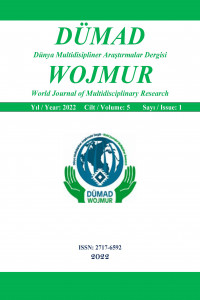Behaviour Patterns Of Azerbaijani And Turkish Proverbs In The Form Of "Evvel-Ahir" (Beginning-End) Or "Herf Uste"
Öz
The article deals with the patterns of Azerbaijani and Turkish proverbs and sayings in the form of "evvel-ahir" which are not found in any source so far. It is noted that one of the most widespread, rich and colourful types of ashug literature is the poetry in the form of "evvel-ahir (beginning-end). Mostly written as couplets, gerayli, rubai, mukhammas, bayati, divani, etc., such poems end on the same letter with which they begin. Such poems are sometimes called "Herfuste" poems (letter by letter). M.Gasimli and M.Allahmanli note that although there is no such strict prohibition, such poems are usually built on consonantal sounds. But there are a lot of "beginning-end" verses that start with vowels. Does 'evvel-ahir' refer to other samples of folklore, for instance, to proverbs? The research shows that there are enough such examples in both Azerbaijani and Turkish proverbs. And this, of course, shows the richness of the ancient Turkic-Oguz tribes in the field of thought, ideological and aesthetic globalism, and their immeasurable richness of artistic taste and cosmic scale. We believe that their study is both interesting and necessary, not only to study the history of folklore, but also to study the beauty of our language and our language in terms of preserving the created spiritual treasure, and to get a clear picture of the proverbs and proverbs as a whole. This of course demonstrates the relevance of the work. Note that we use the term "evvel-ahir proverbs" as well as "dudakdegmez proverbs" for the first time.
Anahtar Kelimeler
folklore Azerbaijani proverbs and parables Turkish proverbs and parables "evvel-ahir" functional-semantic structure.
Kaynakça
- 1. Askerov, Ş, (1998). Dodakdegmezler. Bakı: Çırak.
- 2. Efendiyev, P, (2013). Azerbaycan sözlü halk edebiyatı. Bakı: Elm ve tehsil.
- 3. Kasımlı, M, Allahmanlı, M, (2018). Aşık şeirinin poetik biçimleri ve çeşitleri. Bakı: Elm ve tehsil.
- 4. Memmedov, X, (2022) Azerbaycan ve türkce dudak degmez atasözlerinin işlevsel-anlamsal yapısı // BENGİ Dünya Yörük-Türkmen Araştırmaları Dergisi, Yıl: 5, Sayı: 1.
- 5. Yagubgizi, M, (2013). Atalar sözleri. Bakı: Nurlan.
- 6. Yusif Çotuksöken, (2004). Türkce atasözleri ve deyimler. Gümüşsuyu/İstanbul, Toroslu kitaplığı.
Öz
Bu iş, henüz hiçbir kaynakta bulunmayan "evvel-axır" veya "harf üste" atasözlerinin davranış kalıplarını tartışıyor. Aşık edebiyatının en yaygın, zengin ve renkli türlerinden birinin şiirin "evvel-axır" biçimi olduğu belirtilmektedir. Çoğu zaman beyit, tecnis, geraylı, rubai, mukhammas, bayatı, divani vb türlerde yazılır ve ayetler başladığı gibi aynı harfle de biter. Bu tür şiirlere bazen "harf üste" şiirler denir. M.Gasimli ve M.Allahmanlı, böyle katı bir yasak olmamasına rağmen şiirlerin genellikle ünsüz seslere dayandığını belirtmektedir. Ancak ünlülerle başlayan "evvel-axır" şiirler de vardır. Ama "evvel-axır" veya "harf üste" folklorun diğer örneklerine de uygulanabilir mi, geçerli midir? Araştırmalar, hem Azerbaycan, aynı zamanda Türk atasözlerinde yeterince "evvel-axır" veya "harf üste" olduğunu gösteriyor. Bu, elbette, eski Türk-Oğuz boylarının düşünce, ideolojik ve estetik küreselcilik alanındaki zenginliğine, sanatsal beğenideki muazzam zenginliklerinin yanı sıra kozmik ölçekteki zenginliğine tanıklık eder. Biz onların çalışmasının sadece folklor tarihi üzerine bir çalışma değil, aynı zamanda dilimizin ve dilimizin güzelliği üzerine bir çalışma olduğuna inanıyoruz. Atasözleri ve deyimlerin alan sisteminin genel resmi hakkında fikir, hem ilginç hem de gereklidir. Elbette bu aynı zamanda sorunun aciliyetine de işaret ediyor. "Dudak degmez atasözleri" gibi, "evvel-axır atasözleri" terimi de ilk kez tarafımızdan kullanılmıştır.
Anahtar Kelimeler
Folklor Azerbaycan atasözleri Türk atasözleri "evvel-axır" işlevsel-anlamsal yapı.
Kaynakça
- 1. Askerov, Ş, (1998). Dodakdegmezler. Bakı: Çırak.
- 2. Efendiyev, P, (2013). Azerbaycan sözlü halk edebiyatı. Bakı: Elm ve tehsil.
- 3. Kasımlı, M, Allahmanlı, M, (2018). Aşık şeirinin poetik biçimleri ve çeşitleri. Bakı: Elm ve tehsil.
- 4. Memmedov, X, (2022) Azerbaycan ve türkce dudak degmez atasözlerinin işlevsel-anlamsal yapısı // BENGİ Dünya Yörük-Türkmen Araştırmaları Dergisi, Yıl: 5, Sayı: 1.
- 5. Yagubgizi, M, (2013). Atalar sözleri. Bakı: Nurlan.
- 6. Yusif Çotuksöken, (2004). Türkce atasözleri ve deyimler. Gümüşsuyu/İstanbul, Toroslu kitaplığı.
Ayrıntılar
| Birincil Dil | Türkçe |
|---|---|
| Bölüm | Konferans Bildirisi |
| Yazarlar | |
| Yayımlanma Tarihi | 18 Haziran 2022 |
| Yayımlandığı Sayı | Yıl 2022 Cilt: 5 Sayı: 1 |


